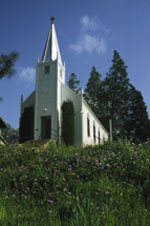
St. Joseph's Catholic Church
 St. Joseph’s Catholic Church is located on a little eminence
overlooking the south end of
Bullion St. Its elegant design and typical New England steeple make St.
Joseph’s one of the
area’s most familiar and photographed landmarks.
St. Joseph’s Catholic Church is located on a little eminence
overlooking the south end of
Bullion St. Its elegant design and typical New England steeple make St.
Joseph’s one of the
area’s most familiar and photographed landmarks.
 The land upon which St. Joseph’s rests was donated by R. S. Miller
and Alex Deering, who were
operating the Mariposa Mine located directly behind the church.
Construction began in the fall of
1862 under the direction of Father Auger and was completed that same
winter. The church was
dedicated by Archbishop Joseph Sadoc Alemany on January 18 of 1863, and
is still in use today.
The land upon which St. Joseph’s rests was donated by R. S. Miller
and Alex Deering, who were
operating the Mariposa Mine located directly behind the church.
Construction began in the fall of
1862 under the direction of Father Auger and was completed that same
winter. The church was
dedicated by Archbishop Joseph Sadoc Alemany on January 18 of 1863, and
is still in use today.
 St. Joseph’s was the first permanent Catholic church in Mariposa
County. Prior to its
construction, Catholic priests saw to the miners’ spiritual needs
wherever they could find a
meeting room, or in temporary churches, otherwise known as tents. The
church, rectory, and
cemetery are all listed on the National Register of Historic Places.
St. Joseph’s was the first permanent Catholic church in Mariposa
County. Prior to its
construction, Catholic priests saw to the miners’ spiritual needs
wherever they could find a
meeting room, or in temporary churches, otherwise known as tents. The
church, rectory, and
cemetery are all listed on the National Register of Historic Places.

 St. Joseph’s Catholic Church is located on a little eminence
overlooking the south end of
Bullion St. Its elegant design and typical New England steeple make St.
Joseph’s one of the
area’s most familiar and photographed landmarks.
St. Joseph’s Catholic Church is located on a little eminence
overlooking the south end of
Bullion St. Its elegant design and typical New England steeple make St.
Joseph’s one of the
area’s most familiar and photographed landmarks. The land upon which St. Joseph’s rests was donated by R. S. Miller
and Alex Deering, who were
operating the Mariposa Mine located directly behind the church.
Construction began in the fall of
1862 under the direction of Father Auger and was completed that same
winter. The church was
dedicated by Archbishop Joseph Sadoc Alemany on January 18 of 1863, and
is still in use today.
The land upon which St. Joseph’s rests was donated by R. S. Miller
and Alex Deering, who were
operating the Mariposa Mine located directly behind the church.
Construction began in the fall of
1862 under the direction of Father Auger and was completed that same
winter. The church was
dedicated by Archbishop Joseph Sadoc Alemany on January 18 of 1863, and
is still in use today. St. Joseph’s was the first permanent Catholic church in Mariposa
County. Prior to its
construction, Catholic priests saw to the miners’ spiritual needs
wherever they could find a
meeting room, or in temporary churches, otherwise known as tents. The
church, rectory, and
cemetery are all listed on the National Register of Historic Places.
St. Joseph’s was the first permanent Catholic church in Mariposa
County. Prior to its
construction, Catholic priests saw to the miners’ spiritual needs
wherever they could find a
meeting room, or in temporary churches, otherwise known as tents. The
church, rectory, and
cemetery are all listed on the National Register of Historic Places.